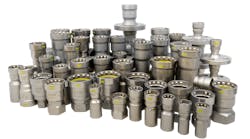THE CALL: A contractor was asking for my help with a high-profile client. He needed to present a variety of options on how to approach the remodeling of this customer's heating system. He wanted ideas. The client, he explained, does corporate brainstorming and consulting for a living.
Once he gave me the address, I realized it must be a very nice living. I had been in most of the homes on this street through the years. It's a short cul-de-sac built in the 1920s with a commanding view of the Ohio River. Consequently, it commands a high real estate value.
I was involved years ago with one project on the street that was a complete interior gut job, down to the studs. It took $4 million to put back together. Yet, despite my plea direct to the owner, he used low-end 9-in. copper-fin baseboard. It seemed that he was using up most of the budget on things like an expensive sculpture in the middle of a new fountain. You remember jobs like that.
This new project was right next door to baseboard central. I walked up to the stately mansion, noticing an inlaid compass point design in the entrance walk. The contractor called to me from the servant's entrance off to the side. We went in to meet with the homeowner.
The troubleshoot
I always look for the radiation when I go into a home. It's a habit of heating men everywhere. This wasn't a baseboard change out. My eyes met a classic, two-pipe, steam, stand-up, cast-iron radiator in that servant's vestibule. You always know it's two-pipe steam when the hand valve has a wooden handle and is located at the top of the radiator. In this home, the valve and steam trap were both marked, "Dunham," one of many quality steam-heating manufacturers during their golden age in the 1920s.
The contractor and I met the homeowner in the kitchen. He offered us cappuccino, since he was making one for himself. He had one of those great big machines that makes froth, noise and whatever. Coffee is one of the few vices I don't enjoy. I can count the number of cups I have consumed on three fingers.
Water hammer occurred late in the steam cycle.
The homeowner was trying to explain what he expected from the contractor. He was waving his arms, writing out thoughts and putting on quite a show. I could easily see that he enjoyed brainstorming.
However, he was asking the contractor to produce about six different quotes based on his "scenarios." It took me a while, but I finally figured out what he really wanted. He wanted quiet.
The steam system was waking up him and his wife in the middle of the night. He wanted a guaranteed repair of his steam system to make it quiet, or five other options on how to heat the house. I was there to take up the challenge of making this system heat the home without that annoying BANG in the night.
We did the tour of the basement. I looked at every pipe possible. I noticed that the system hadn't been changed much through the years. The steam supply-and-return piping was pretty much original. The pitch looked good. The five-year-old boiler's piping had been done correctly. The gauge glass was rock steady and at the right level. Nothing was jumping out as the culprit.
I asked the homeowner if it only made noise at night. Water hammer causes can be determined based upon when they happen in the steam cycle. This sounded like the hammer occurred late in the cycle, after the system was running for a long time, such as in the middle of a cold night. He agreed with this concept.
I told the contractor and homeowner that it would be tough to guarantee a quiet system with one repair. Too many things can cause a steam system to make noise. But we could approach the problem one step at a time. The first step for this job was trap maintenance. The steam traps didn't show any wrench marks or indications that they had been serviced since, probably, 1927.
I explained that steam can find its way past a failed steam trap and play a tune in the return pipes. This doesn't happen at the start of the steam cycle, because the steam is being condensed by the cold metal of the cast-iron radiators. But with repeated long steam cycles during cold nights, steam gets through the warm radiator and past the trap to cause water hammer in the dry returns. The trespassing steam easily whips up slugs of condensate in the small return pipes. The consultant grasped the theory and demanded a quote based on that scenario.
The contractor had a list of all the traps — there were only two models. A call to Tunstall in Massachusetts confirmed that repair capsules could be ordered and recommended new caps. We could then use a capsule with a very positive seal around the old trap seats. With these in place, steam would stay in the radiators and not stray to the return piping.
The follow-up
The contractor installed repair capsules in all the traps. The job went very smoothly. It checked out fine after the repairs and ran quietly through some cold early-winter nights.
However, the homeowner was soon reporting a noise above her BMW. I volunteered to go out again since piping does run in the ceiling of the three-car garage, but the contractor said he wanted to send one of his techs out first to investigate.
The tech couldn't find anything wrong with the steam system. The noise in the garage wasn't water hammer coming from the dry return pipes. The repair capsules had fixed that problem. The tech discovered that the noise was coming from a pipe going to that cappuccino machine in the kitchen.
The contractor was relieved that it wasn't his problem and he didn't have to quote five more options. I was glad that it only took the repair capsules to make an audible difference in the steam system. The homeowner, I'm sure, was consulting with whoever installed the expensive coffee maker. I can't make this kind of stuff up.
Patrick Linhardt is the Hydronic Heating Division manager at Habegger Corp. – Carrier Division in Cincinnati. To order his book, Linhardt's Field Guide to Steam Heating, visit www.steamupairoutwaterback.com or call 513/703-5347.

